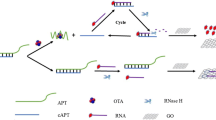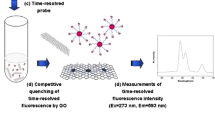Abstract
A versatile and cost-effective aptamer-based fluorescence quenching assay is described for the detection of the mycotoxin zearalenone (ZEN). Exfoliated functional graphene oxide (FGO) of high water-dispersibility is adopted as an effective fluorescence quencher of the fluorescence of FAM. Quenching properties of graphite, graphene oxide (GO) and FGO were investigated, and FGO is found to be the most efficient quencher. FGO therefore was used in an aptamer-based detection format that allows ZEN to be determined in the concentration range of 0.5 to 64 ng·mL−1 with a limit of detection of 0.5 ng·mL−1. The aptamer assay has good repeatability and reproducibility (n ≥ 4). Selectivity of the aptamer assay against a set of possible interferents is substantiated. This aptasensing assay was successfully applied to the determination of ZEN in (spiked) alcoholic beverage samples, beer and wine, and recovery values in the range of 87 to 96% were obtained for the determination of ZEN at levels as low as 1–16 ng mL−1.

Comparison of fluorescence quenching efficiency of graphite, graphene oxide (GO) and functional graphene oxide (FGO). Fluorophore: Fluorescein amidite (FAM).






Similar content being viewed by others
References
Liu N, Nie D, Zhao Z et al (2015) Ultrasensitive immunoassays based on biotin–streptavidin amplified system for quantitative determination of family zearalenones. Food Control 57:202–209. https://doi.org/10.1016/j.foodcont.2015.03.049
Wang Y, Li Z, Wang J et al (2011) Graphene and graphene oxide: biofunctionalization and applications in biotechnology. Trends Biotechnol 29:205–212. https://doi.org/10.1016/j.tibtech.2011.01.008
Vashist SK, Luong JHT (2015) Recent advances in electrochemical biosensing schemes using graphene and graphene-based nanocomposites. Carbon N Y 84:519–550. https://doi.org/10.1016/j.carbon.2014.12.052
Song Y, Luo Y, Zhu C et al (2016) Recent advances in electrochemical biosensors based on graphene two-dimensional nanomaterials. Biosens Bioelectron 76:195–212. https://doi.org/10.1016/j.bios.2015.07.002
Wu S, He Q, Tan C et al (2013) Graphene-based electrochemical sensors. Small 9:1160–1172. https://doi.org/10.1002/smll.201202896
Wang L, Zhu J, Han L et al (2012) Graphene-based aptamer logic gates and their application to multiplex detection. ACS Nano 6:6659–6666. https://doi.org/10.1021/nn300997f
Dong H, Gao W, Yan F et al (2010) Fluorescence resonance energy transfer between quantum dots and graphene oxide for sensing biomolecules. Anal Chem 82:5511–5517. https://doi.org/10.1021/ac100852z
Lin W, Tian B, Zhuang P et al (2016) Graphene-based fluorescence-quenching-related Fermi level elevation and electron-concentration surge. Nano Lett 16:5737–5741. https://doi.org/10.1021/acs.nanolett.6b02430
Lu C, Yang H, Zhu C et al (2009) A graphene platform for sensing biomolecules. Angew Chem 121:4879–4881. https://doi.org/10.1002/ange.200901479
Xing X, Liu X, Yue-He, et al (2012) Graphene oxide based fluorescent aptasensor for adenosine deaminase detection using adenosine as the substrate. Biosens Bioelectron 37:61–67. doi:https://doi.org/10.1016/j.bios.2012.04.037
Bai Y, Feng F, Zhao L et al (2014) A turn-on fluorescent aptasensor for adenosine detection based on split aptamers and graphene oxide. Analyst 139:1843. https://doi.org/10.1039/c4an00084f
Cao L, Cheng L, Zhang Z et al (2012) Visual and high-throughput detection of cancer cells using a graphene oxide-based FRET aptasensing microfluidic chip. Lab Chip 12:4864. https://doi.org/10.1039/c2lc40564d
Kushwaha HS, Sao R, Vaish R (2014) Label free selective detection of estriol using graphene oxide-based fluorescence sensor. J Appl Phys 116:34701. https://doi.org/10.1063/1.4890024
He Y, Lin Y, Tang H, Pang D (2012) A graphene oxide-based fluorescent aptasensor for the turn-on detection of epithelial tumor marker mucin 1. Nano 4:2054. https://doi.org/10.1039/c2nr12061e
Song Y, Li W, Duan Y et al (2014) Nicking enzyme-assisted biosensor for salmonella enteritidis detection based on fluorescence resonance energy transfer. Biosens Bioelectron 55:400–404. https://doi.org/10.1016/j.bios.2013.12.053
Gao L, Li Q, Li R et al (2015) Highly sensitive detection for proteins using graphene oxide-aptamer based sensors. Nano 7:10903–10907. https://doi.org/10.1039/C5NR01187F
Chang H, Tang L, Wang Y et al (2010) Graphene fluorescence resonance energy transfer Aptasensor for the thrombin detection. Anal Chem 82:2341–2346. https://doi.org/10.1021/ac9025384
Wu S, Duan N, Ma X et al (2012) Multiplexed fluorescence resonance energy transfer Aptasensor between Upconversion nanoparticles and graphene oxide for the simultaneous determination of mycotoxins. Anal Chem 84:6263–6270. https://doi.org/10.1021/ac301534w
Zhang C, Yuan Y, Zhang S et al (2011) Biosensing platform based on fluorescence resonance energy transfer from Upconverting nanocrystals to graphene oxide. Angew Chem Int Ed 50:6851–6854. https://doi.org/10.1002/anie.201100769
Zeng X, Ma S, Bao J et al (2013) Using graphene-based Plasmonic nanocomposites to quench energy from quantum dots for signal-on Photoelectrochemical Aptasensing. Anal Chem 85:11720–11724. https://doi.org/10.1021/ac403408y
Liu C, Wang Z, Jia H, Li Z (2011) Efficient fluorescence resonance energy transfer between upconversion nanophosphors and graphene oxide: a highly sensitive biosensing platform. Chem Commun 47:4661. https://doi.org/10.1039/c1cc10597c
Yu Y, Cao Q, Zhou M, Cui H (2013) A novel homogeneous label-free aptasensor for 2,4,6-trinitrotoluene detection based on an assembly strategy of electrochemiluminescent graphene oxide with gold nanoparticles and aptamer. Biosens Bioelectron 43:137–142. https://doi.org/10.1016/j.bios.2012.12.018
Lu Z, Chen X, Wang Y et al (2015) Aptamer based fluorescence recovery assay for aflatoxin B1 using a quencher system composed of quantum dots and graphene oxide. Microchim Acta 182:571–578. https://doi.org/10.1007/s00604-014-1360-0
Hu X, Mu L, Wen J, Zhou Q (2012) Covalently synthesized graphene oxide-aptamer nanosheets for efficient visible-light photocatalysis of nucleic acids and proteins of viruses. Carbon. https://doi.org/10.1016/j.carbon.2012.02.038
Cai R, Rao W, Zhang Z et al (2014) An imprinted electrochemical sensor for bisphenol a determination based on electrodeposition of a graphene and ag nanoparticle modified carbon electrode. Anal Methods 6:1590. https://doi.org/10.1039/c3ay42125b
Murphy CB, Zhang Y, Troxler T et al (2004) Probing Förster and Dexter energy-transfer mechanisms in fluorescent conjugated polymer Chemosensors. J Phys Chem B 108:1537–1543. https://doi.org/10.1021/jp0301406
Zu F, Yan F, Bai Z et al (2017) The quenching of the fluorescence of carbon dots: a review on mechanisms and applications. Microchim Acta 184:1899–1914. https://doi.org/10.1007/s00604-017-2318-9
Goud KY, Hayat A, Catanante G, Satyanarayana M, Gobi KV, Marty JL (2017) An electrochemical aptasensor based on functionalized graphene oxide assisted electrocatalytic signal amplification of methylene blue for aflatoxin B1 detection. Electrochim Acta 244:96–103. https://doi.org/10.1016/j.electacta.2017.05.089
Sun X, Liu Z, Welsher K, Robinson JT, Goodwin A, Zaric S, Dai H (2008) Nano-graphene oxide for cellular imaging and drug delivery. Nano Res 1(3):203–212. https://doi.org/10.1007/s12274-008-8021-8
Sheng L, Ren J, Miao Y et al (2011) PVP-coated graphene oxide for selective determination of ochratoxin a via quenching fluorescence of free aptamer. Biosens Bioelectron 26:3494–3499. https://doi.org/10.1016/j.bios.2011.01.032
Fang G, Fan C, Liu H et al (2014) A novel molecularly imprinted polymer on CdSe/ZnS quantum dots for highly selective optosensing of mycotoxin zearalenone in cereal samples. RSC Adv 4:2764–2771. https://doi.org/10.1039/C3RA45172K
Chen X, Huang Y, Duan N et al (2013) Selection and identification of ssDNA aptamers recognizing zearalenone. Anal Bioanal Chem 405:6573–6581. https://doi.org/10.1007/s00216-013-7085-9
Acknowledgments
This research work was supported by NATO SPS program, project NUKR.SFPP 984637. K. Yugender Goud would like to thank EUPHRATES Program for ERASMUS Mundus Doctoral Fellowship.
Author information
Authors and Affiliations
Corresponding author
Ethics declarations
The author(s) declare that they have no competing interests.
Rights and permissions
About this article
Cite this article
Yugender Goud, K., Hayat, A., Satyanarayana, M. et al. Aptamer-based zearalenone assay based on the use of a fluorescein label and a functional graphene oxide as a quencher. Microchim Acta 184, 4401–4408 (2017). https://doi.org/10.1007/s00604-017-2487-6
Received:
Accepted:
Published:
Issue Date:
DOI: https://doi.org/10.1007/s00604-017-2487-6




